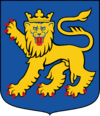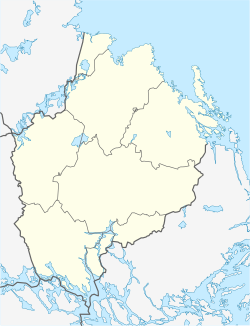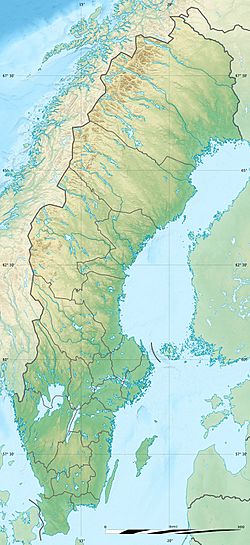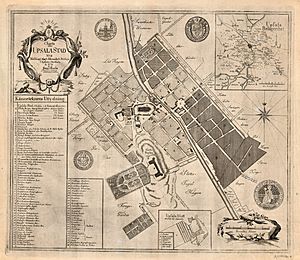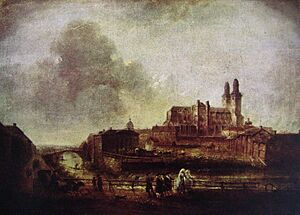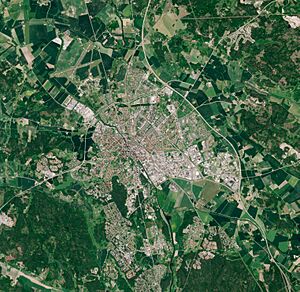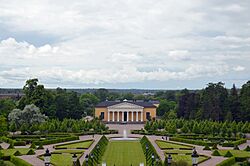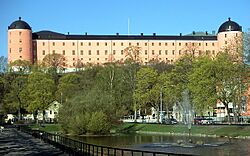Uppsala facts for kids
Quick facts for kids
Uppsala
|
||
|---|---|---|
|
City
|
||
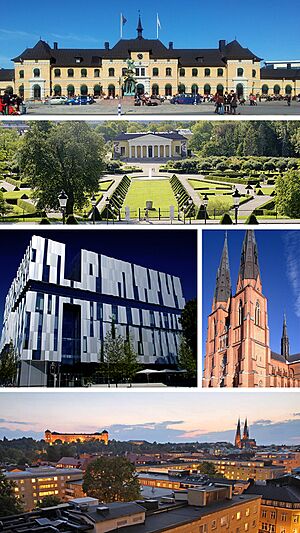
Top to bottom and left to right: Old Central Station; Botanical Garden; Concert & Congress Hall; cathedral; skyline with castle and cathedral.
|
||
|
||
| Country | ||
| Province | ||
| County | Uppsala County | |
| Municipality | Uppsala Municipality | |
| Area | ||
| • Total | 48.77 km2 (18.83 sq mi) | |
| Elevation | 15 m (49 ft) | |
| Population
(31 December 2019)
|
||
| • Total | 177,074 | |
| • Density | 3,630.8/km2 (9,403.7/sq mi) | |
| Demonym(s) | Uppsalabo, Upsaliensare | |
| Time zone | UTC+1 (CET) | |
| • Summer (DST) | UTC+2 (CEST) | |
| Postal code |
75x xx
|
|
| Area code(s) | +46(0) 18 | |
Uppsala is a big city in Sweden. It is the fourth-largest city in the country. About 177,000 people lived there in 2019. Uppsala is the main city of Uppsala County.
The city is located about 71 kilometers (44 miles) north of Stockholm, the capital of Sweden. Since 1164, Uppsala has been the most important religious center in Sweden. It is home to the Archbishop of the Church of Sweden. Uppsala also has Uppsala Cathedral, which is the largest cathedral in Scandinavia. Kings and queens of Sweden used to be crowned there.
Uppsala Castle was built by King Gustav Vasa. It was once a royal home and helped make Uppsala a very important city in Sweden's history. Today, the castle is where the leader of Uppsala County lives.
Uppsala University was started in 1477. It is the oldest university in Scandinavia. Many famous thinkers have worked in Uppsala. These include Anders Celsius, who invented the temperature scale we use today, and Carl Linnaeus, who created the system for naming living things.
Other famous people from Uppsala include filmmaker Ingmar Bergman and diplomat Dag Hammarskjöld.
Contents
History of Uppsala
Uppsala was not always called Uppsala. The original name belonged to a place a few kilometers north, now called Gamla Uppsala (Old Uppsala). The city we know today was once called Östra Aros.
Old Uppsala was a very important religious place for people who followed old Norse beliefs. It had a famous temple dedicated to Norse gods.
In 1160, King Eric Jedvardsson was killed near the church in Östra Aros. He later became a saint. In 1274, Östra Aros became the main city in the area. When the old cathedral in Gamla Uppsala burned down, the archbishop and saint's relics moved to Östra Aros. This is where the current Uppsala Cathedral was built. It opened in 1435. The cathedral is built in a Gothic style and is one of the biggest churches in northern Europe. Its towers are 118.7 meters (389 feet) tall.
The city is home to the oldest university in Scandinavia, founded in 1477. Carl Linnaeus, a famous scientist, lived in Uppsala for many years. You can still visit his house and garden. Uppsala also has Uppsala Castle, which was built in the 1500s. A big fire in 1702 caused a lot of damage to the city.
Even though some old buildings were removed in the 1960s and 1970s, many historic places still stand, especially in the western part of the city. The city's coat of arms, which shows a lion, has been used since 1737. It probably relates to the royal lion on the Coat of Arms of Sweden.
Geography of Uppsala
Uppsala is located on flat, fertile land. The small Fyris River (Fyrisån) flows through the city, surrounded by green plants. Next to the river is a hill called Uppsalaåsen, about 30 meters (98 feet) high. Uppsala Castle is on this hill, and you can see much of the city from there. The central park, Stadsskogen (City Forest), offers places for people to relax and enjoy nature.
Many people who live in Uppsala work in Stockholm, which is about 70 kilometers (43 miles) away. A train ride to Stockholm-Arlanda Airport takes only 17 minutes, making it easy to travel by air. Uppsala is on Sweden's east coast, similar to Stockholm.
Uppsala's main shopping area is quite small. The city has a clear division between its historic and modern parts. The cathedral, castle, and university buildings are mostly in the western part of the city. This area has old streets, river views, and parks. The main shopping streets and square are on the eastern side of the river. In recent years, more shops have moved to malls outside the city center.
Climate in Uppsala
Uppsala has a climate with cold winters and warm summers. Even though it is far north, its winters are not as cold as other places at the same latitude. This is because of the Gulf Stream, which brings warmer ocean currents. For example, in January, the average temperature is around -2.7°C (27.1°F).
Uppsala has seen very different temperatures. The highest temperature ever recorded was 37.4°C (99.3°F) on July 9, 1933. The lowest was -39.5°C (-39.1°F) on January 24, 1875.
Winters usually start in late November and last until mid-March. Summers typically begin in mid-May and end in late September. Rain is most common from June to November. Snow usually falls between November and March.
Economy and Business
Uppsala has a growing economy in many areas. It is especially known for its medical research and its strong position in biotechnology. Many companies in these fields are located here, including:
- Abbott Medical Optics (AMO)
- Cytiva
- Pfizer
- Phadia (now part of Thermo Fisher Scientific)
- Fresenius
- Q-Med (bioscience)
- Biotage
- Skandion Kliniken (a special cancer treatment center)
- Uppsala Monitoring Centre (which works with the WHO on medical safety)
- IAR Systems
Higher Education
Uppsala is a major center for learning.
Universities
- Uppsala University: This university was founded in 1477. It has a famous old room called an anatomical theatre, built by a scientist named Olof Rudbeck. This room is now a museum. The university also has 13 student groups called "nations," which traditionally represent different parts of Sweden.
- Swedish University of Agricultural Sciences (SLU): This university focuses on agriculture and related sciences.
Other Schools
- Johannelunds Teologiska Högskola: A school for studying theology, which is about religion.
- The Newman Institute: A Catholic school founded in 2001.
- Pingströrelsens teologiska seminarium: A Pentecostal theological school.
Museums and Sights
The Fyris River divides Uppsala into two main parts. The western side has most of the historic sights and university buildings. It has old streets, river views, and parks. The eastern side is more modern, with shops and offices.
The most famous building in Uppsala is the Domkyrka (Uppsala Cathedral). It is Scandinavia's largest church, standing 118.7 meters (389 feet) tall. The cathedral and Uppsala Castle have been the most important buildings in Uppsala's skyline for centuries.
Near the cathedral is the Gustavianum. It was built in 1625 as the main university building. Today, it is a museum with collections of old Nordic items, Egyptian artifacts, and university history. It also has a perfectly preserved 17th-century anatomical theater. Next to Gustavianum is the Archbishop's Palace, where the leader of the Church of Sweden lives.
Across from Gustavianum is the University Hall, built between 1879 and 1886. It looks like an Italian Renaissance building. The university's coin collection is also here.
Not far from the university is the Uppsala University Library (Carolina Rediviva). It is the largest library in Sweden, with over 5 million books. The building was built from 1820 to 1841.
On a hill about 35 meters (115 feet) high, you will find Uppsala Castle. King Gustav Vasa started building it in 1549. Today, the castle has several museums, including an art museum. It is also the home of the Governor of Uppsala County.
Uppsala has several botanical gardens linked to the famous scientist Carl Linnaeus. These include the Botanic Garden near the castle, the Linnaean Garden in the city center, and Linnaeus Hammarby, which was Linnaeus's summer home outside the city.
About 5 kilometers (3 miles) north of Uppsala is Gamla Uppsala (Old Uppsala). This was the original settlement of Uppsala before Christianity. You can still see large burial mounds of ancient kings there. The old cathedral from 1164 AD is also there. It is believed to be built over an old pagan temple. This site was a very important religious center in Scandinavia long ago. The Gamla Uppsala Museum shows items found during digs there.
Transportation
Roads
The European route E4 highway runs east of Uppsala. It is the main road connecting the city to other places. Other smaller roads also link Uppsala to nearby towns like Enköping and Sala.
Public Transport
Buses
Buses in Uppsala are run by UL. There are two types of bus lines: city buses and county buses. City buses are green and travel within Uppsala. County buses are yellow and travel to wider parts of the municipality and county. Some city buses are called mjuka linjer ("soft lines"). These buses have stops closer to places like hospitals to help older people and those with disabilities.
Trains
Uppsala Central Station is one of Sweden's busiest train stations. About 45,000 passengers use it every day. Many train companies serve the station, including Mälartåg, SJ, and SL. Vy runs night trains to Narvik in Norway.
Trains from Uppsala Central Station go in three directions:
- South: to Arlanda (the airport), Stockholm, and Linköping.
- Northwest: to Dalarna and Sala.
- North: to Gävle, Sundsvall, Östersund, and other parts of northern Sweden.
Airports
Uppsala does not have its own public airport. However, Arlanda Airport is only about 30 kilometers (19 miles) south of Uppsala. There is a military air base north of Uppsala called Ärna Air Base. Some people have suggested making it a public airport, but it is still only for military use.
Sports
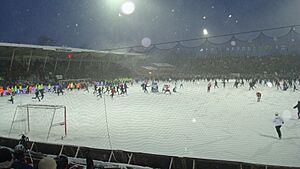
Fyrishov is the largest sports arena in Uppsala. It is Sweden's fourth most visited sports center. It has areas for swimming, sports events, and fun activities. Fyrishov includes indoor sports areas, summer sports areas, and a large water park with slides and pools. You can also stay at the Fyrishov cabin area and eat at its restaurants. Fyrishov also runs Gottsundabadet, another swimming facility.
Fyrishov AB also helps run "Tävlingsstaden Uppsala" (Competition City Uppsala). This project works with sports groups, the city, and hotels to make Uppsala a top sports city in Sweden. Many national and international sports events are held here each year.
Uppsala's basketball team, Uppsala Basket, plays its home games at Fyrishov. Other sports clubs that use Fyrishov include Uppsala's athletic club, fencing club, judo club, volleyball club, and weightlifting club. Upsala Simsällskap is one of the world's oldest swimming clubs.
The sport that attracts the most fans in Uppsala is floorball. The city's two teams in the Swedish Super League, Storvreta IBK and IK Sirius IBK, play at Fyrishov.
The Swedish bandy final is a very popular sports event. It used to be held at Studenternas IP in Uppsala from 1991 to 2012. After being played in Stockholm for a few years, it returned to Uppsala in 2018. More than 20,000 people usually watch this final.
Once a year, students from the Uppsala Union of Science and Engineering Students have a fun river rafting event on the Fyris River. They build rafts from styrofoam for this event.
Other sports clubs in Uppsala include:
- Dalkurd FF (football)
- Almtuna IS (ice hockey)
- Gamla Upsala SK (football)
- IF Vindhemspojkarna (football)
- IK Sirius (multi-sport club)
- IK Sirius Fotboll (football)
- Unik FK (football)
- Upsala IF (athletics)
- Uppsala Judoklubb (judo)
- Uppsala 86ers (American football)
- Upsala Fäktning (fencing)
- Upsala allmänna schacksällskap (UASS) (chess)
- Uppsala Akademiska Roddarsällskap (UARS) (rowing)
Notable People
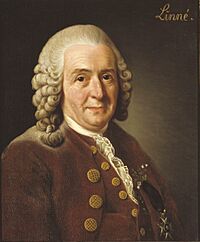
Many well-known people have connections to Uppsala:
- Adiam (1982–), musician
- Magdalena Andersson (1967–), former Prime Minister of Sweden
- Svante Arrhenius (1859–1927), scientist
- Ingmar Bergman (1918–2007), filmmaker
- Jöns Jakob Berzelius (1779–1848), chemist
- Anders Celsius (1701–1744), astronomer
- Malena Ernman (1970–), opera singer
- Dag Hammarskjöld (1905–1961), diplomat
- Viveca Lindfors (1920–1995), actress
- Carl Linnaeus (1707–1778), scientist
- Veronica Maggio (1981–), singer
- Hans Rosling (1948–2017), doctor and statistician
- Emanuel Swedenborg (1688-1772), scientist and thinker
- Anders Tegnell (1956–), doctor and public health official
- Snoh Aalegra (1987- ), musician
Images for kids
See also
 In Spanish: Upsala para niños
In Spanish: Upsala para niños


